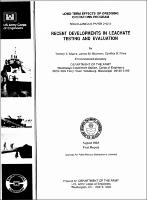Please use this identifier to cite or link to this item:
https://hdl.handle.net/11681/3048| Title: | Recent developments in leachate testing and evaluation |
| Authors: | Long-Term Effects of Dredging Operations Program (U.S.) Myers, Tommy E. Brannon, James M. Price, Cynthia B. |
| Keywords: | Contaminant mobility Contaminated sediment Dredging Dredged material Dredging spoil Leach tests Environmental aspects |
| Publisher: | Environmental Laboratory (U.S.) Engineer Research and Development Center (U.S.) |
| Description: | Miscellaneous Paper Abstract: Laboratory studies of sediment leaching are being conducted at the U.S. Army Engineer Waterways Experiment Station. The purpose of these studies is to develop laboratory tests and data interpretation algorithms for predicting leachate quality in confined disposal facilities (CDFs) for dredged material. Leachate quality predictions are needed for evaluation of potential impacts of leachate seepage on foundation soils and groundwater. Two types of laboratory leach tests are under investigation, batch and column. A sequential batch leach test is being developed to provide a short-term laboratory test that describes the distribution of contaminants between aqueous and solid phases as sediment solids are exposed to increasing amounts of water. Column leach tests are being developed as laboratory-scale physical models of contaminant leaching in a CDF. Significant progress has been made in the development of the sequential batch leach test, Research has shown that sequential batch leach tests conducted at a liquids-to-solids ratio of 4 to 1 (by weight) and a shake time of 24 hr provide the type of information needed for predicting probable long-term contaminant leaching characteristics. Progress in developing a column leach test has been slower, but is promising. Current studies show that sediment salinity and oxidation status significantly affect contaminant leaching. Sediments from freshwater environments generally behave according to classical desorption theory. Initial concentrations of contaminants in leachate represent worst-case leachate quality, and leachate quality will improve over time as dredged material solids are contacted by additional water infiltrating from the surface. However, leaching of sediments from estuarine environments with freshwater results in nonideal behavior that significantly complicates prediction of long-term leaching trends. Nonideal behavior is due to release of sediment organic colloids as ionic strength is decreased through salt washout. Data from sequential batch leach tests clearly indicate that elution of several pore volumes through estuarine dredged material is necessary to produce maximum concentrations of contaminants in leachate. In CDFs, the time scale for worst-case leachate quality is on the order of tens of years or more, depending on dredged material hydraulic conductivity and site-specific climatological factors. Extended dewatering and oxidation of sediments tend to mobilize metals and volatilize or biodegrade organics. Sequential batch leach tests are being conducted on sediments aged for 6 months in thin lifts to investigate the dependency of contaminant mobility on pH changes associated with slow changes in oxidation-reduction potential. The available data indicate that after 6 months exposure to air, pH in some sediments decreases significantly with a companion increase in leachate metal concentrations. Comparisons of observed column elution histories with predictions based on sequential batch leach test data and mass transport theory indicate qualitative agreement. Quantitative comparisons, however, have been limited because of the column leach apparatus. The major deficiencies are the limited number of pore volumes that can be eluted in a reasonable period of time without increasing pore water velocities to unreasonable values and the potential for sample deterioration during extended elution periods. These deficiencies have been corrected by redesigning the column leach apparatus. Studies are ongoing with the improved design to evaluate performance. Other areas to be investigated in current or planned studies include detailed batch studies of the effects of organic colloids on leachate quality, development of a column contaminant transport equation that includes salt washout and colloidal organic matter effects on leachate quality, and coupling of leachate quality information from batch and column leach tests with the Hydrologic Evaluation of Landfill Performance water balance model. |
| Rights: | Approved for public release; distribution is unlimited. |
| URI: | http://hdl.handle.net/11681/3048 |
| Appears in Collections: | Miscellaneous Paper |
